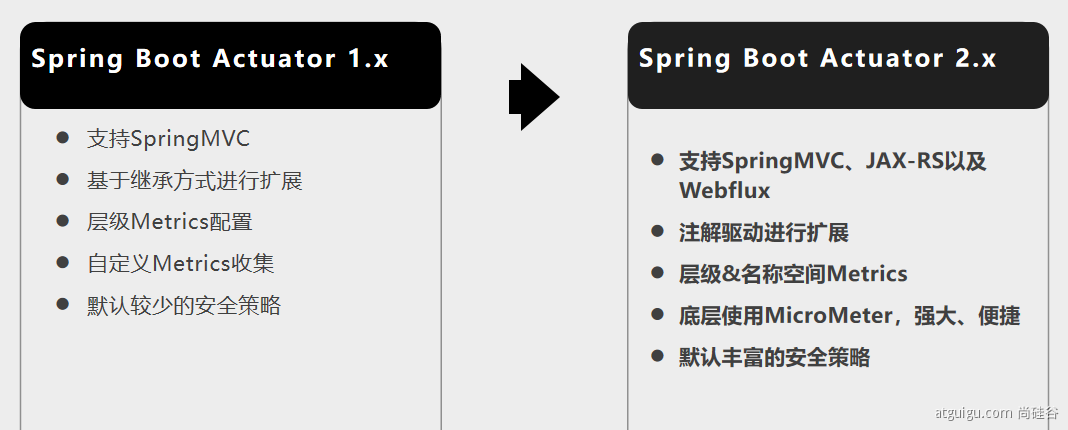指标监控
1、SpringBoot Actuator
1、简介
未来每一个微服务在云上部署以后,我们都需要对其进行监控、追踪、审计、控制等。SpringBoot就抽取了Actuator场景,使得我们每个微服务快速引用即可获得生产级别的应用监控、审计等功能。
<dependency>
<groupId>org.springframework.boot</groupId>
<artifactId>spring-boot-starter-actuator</artifactId>
</dependency>
2、1.x与2.x的不同

3、如何使用
- 引入场景
- 访问 http://localhost:8080/actuator/**
- 暴露所有监控信息为HTTP
management:
endpoints:
enabled-by-default: true #暴露所有端点信息
web:
exposure:
include: '*' #以web方式暴露
4、可视化
https://github.com/codecentric/spring-boot-admin
2、Actuator Endpoint
1、最常使用的端点
|
ID |
描述 |
|
|
暴露当前应用程序的审核事件信息。需要一个 |
|
|
显示应用程序中所有Spring Bean的完整列表。 |
|
|
暴露可用的缓存。 |
|
|
显示自动配置的所有条件信息,包括匹配或不匹配的原因。 |
|
|
显示所有 |
|
|
暴露Spring的属性 |
|
|
显示已应用的所有Flyway数据库迁移。 |
|
|
显示应用程序运行状况信息。 |
|
|
显示HTTP跟踪信息(默认情况下,最近100个HTTP请求-响应)。需要一个 |
|
|
显示应用程序信息。 |
|
|
显示Spring |
|
|
显示和修改应用程序中日志的配置。 |
|
|
显示已应用的所有Liquibase数据库迁移。需要一个或多个 |
|
|
显示当前应用程序的“指标”信息。 |
|
|
显示所有 |
|
|
显示应用程序中的计划任务。 |
|
|
允许从Spring Session支持的会话存储中检索和删除用户会话。需要使用Spring Session的基于Servlet的Web应用程序。 |
|
|
使应用程序正常关闭。默认禁用。 |
|
|
显示由 |
|
|
执行线程转储。 |
如果您的应用程序是Web应用程序(Spring MVC,Spring WebFlux或Jersey),则可以使用以下附加端点:
|
ID |
描述 |
|
|
返回 |
|
|
通过HTTP暴露JMX bean(需要引入Jolokia,不适用于WebFlux)。需要引入依赖 |
|
|
返回日志文件的内容(如果已设置 |
|
|
以Prometheus服务器可以抓取的格式公开指标。需要依赖 |
最常用的Endpoint
- Health:监控状况
- Metrics:运行时指标
- Loggers:日志记录
2、Health Endpoint
健康检查端点,我们一般用于在云平台,平台会定时的检查应用的健康状况,我们就需要Health Endpoint可以为平台返回当前应用的一系列组件健康状况的集合。
重要的几点:
- health endpoint返回的结果,应该是一系列健康检查后的一个汇总报告
- 很多的健康检查默认已经自动配置好了,比如:数据库、redis等
- 可以很容易的添加自定义的健康检查机制
3、Metrics Endpoint
提供详细的、层级的、空间指标信息,这些信息可以被pull(主动推送)或者push(被动获取)方式得到;
- 通过Metrics对接多种监控系统
- 简化核心Metrics开发
- 添加自定义Metrics或者扩展已有Metrics
4、管理Endpoints
1、开启与禁用Endpoints
- 默认所有的Endpoint除过shutdown都是开启的。
- 需要开启或者禁用某个Endpoint。配置模式为 management.endpoint.<endpointName>.enabled = true
management:
endpoint:
beans:
enabled: true
- 或者禁用所有的Endpoint然后手动开启指定的Endpoint
management:
endpoints:
enabled-by-default: false
endpoint:
beans:
enabled: true
health:
enabled: true
2、暴露Endpoints
支持的暴露方式
- HTTP:默认只暴露health和info Endpoint
- JMX:默认暴露所有Endpoint
- 除过health和info,剩下的Endpoint都应该进行保护访问。如果引入SpringSecurity,则会默认配置安全访问规则
|
ID |
JMX |
Web |
|
|
Yes |
No |
|
|
Yes |
No |
|
|
Yes |
No |
|
|
Yes |
No |
|
|
Yes |
No |
|
|
Yes |
No |
|
|
Yes |
No |
|
|
Yes |
Yes |
|
|
N/A |
No |
|
|
Yes |
No |
|
|
Yes |
Yes |
|
|
Yes |
No |
|
|
N/A |
No |
|
|
N/A |
No |
|
|
Yes |
No |
|
|
Yes |
No |
|
|
Yes |
No |
|
|
Yes |
No |
|
|
N/A |
No |
|
|
Yes |
No |
|
|
Yes |
No |
|
|
Yes |
No |
|
|
Yes |
No |
|
|
Yes |
No |
3、定制 Endpoint
1、定制 Health 信息
2、定制info信息
常用两种方式
1、编写配置文件
info: appName: boot-admin version: 2.0.1 mavenProjectName: @project.artifactId@ #使用@@可以获取maven的pom文件值 mavenProjectVersion: @project.version@
2、编写InfoContributor
import java.util.Collections;
import org.springframework.boot.actuate.info.Info;
import org.springframework.boot.actuate.info.InfoContributor;
import org.springframework.stereotype.Component;
@Component
public class ExampleInfoContributor implements InfoContributor {
@Override
public void contribute(Info.Builder builder) {
builder.withDetail("example",
Collections.singletonMap("key", "value"));
}
}
http://localhost:8080/actuator/info 会输出以上方式返回的所有info信息
3、定制Metrics信息
1、SpringBoot支持自动适配的Metrics
- JVM metrics, report utilization of:
- Various memory and buffer pools
- Statistics related to garbage collection
- Threads utilization
- Number of classes loaded/unloaded
- CPU metrics
- File descriptor metrics
- Kafka consumer and producer metrics
- Log4j2 metrics: record the number of events logged to Log4j2 at each level
- Logback metrics: record the number of events logged to Logback at each level
- Uptime metrics: report a gauge for uptime and a fixed gauge representing the application’s absolute start time
- Tomcat metrics (
server.tomcat.mbeanregistry.enabledmust be set totruefor all Tomcat metrics to be registered) - Spring Integration metrics
2、增加定制Metrics
class MyService{
Counter counter;
public MyService(MeterRegistry meterRegistry){
counter = meterRegistry.counter("myservice.method.running.counter");
}
public void hello() {
counter.increment();
}
}
//也可以使用下面的方式
@Bean
MeterBinder queueSize(Queue queue) {
return (registry) -> Gauge.builder("queueSize", queue::size).register(registry);
}
4、定制Endpoint
@Component
@Endpoint(id = "container")
public class DockerEndpoint {
@ReadOperation
public Map getDockerInfo(){
return Collections.singletonMap("info","docker started...");
}
@WriteOperation
private void restartDocker(){
System.out.println("docker restarted....");
}
}
场景:开发ReadinessEndpoint来管理程序是否就绪,或者LivenessEndpoint来管理程序是否存活;